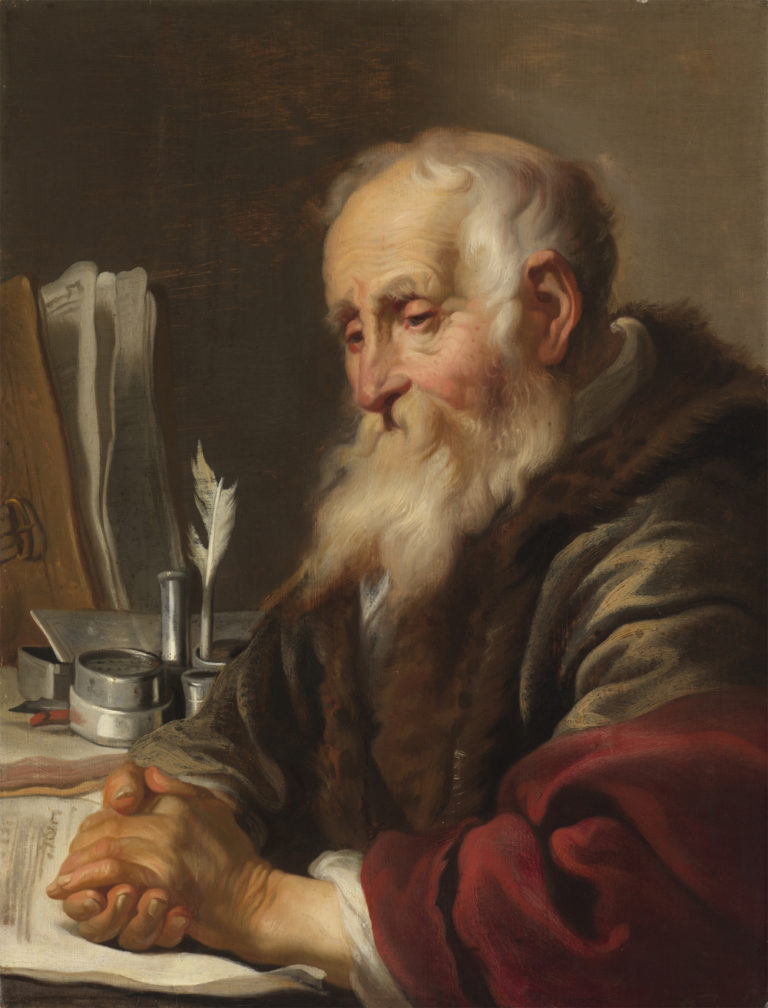An elderly, bearded scholar in a fur-lined cloak sits at a desk with an open book, surrounded by the tools of his pursuits: an impressive inkwell, a well-worn quill pen shorn of barbs, a quill box, a “pounce” caster, a stick of red sealing wax (with its soot-blackened ring), and a leather portfolio containing a sheaf of writings.1 The quill rests in the inkwell and the adjacent quill box’s lid remains ajar, indicating that this scholar has just finished composing the text before him. With his hands clasped, he sits in a moment of quiet repose, deeply lost in thought. A warm, broad light washes over him, emphasizing his flushed cheeks and knotted brow. The scholar’s attire is a wonderful contrast of textures, from the thin linen shirt to the heavy gray cloak with a rich fur collar and shimmering velvet sleeves.
Jacob Adriaensz Backer (1608/9–51) painted A Scholar at His Desk around 1632 in Leeuwarden, when he was working in the studio of Lambert Jacobsz (1598–1636), with whom he had trained since moving from Amsterdam to the Frisian capital in the latter half of the 1620s. Jacobsz, like Backer, was a Mennonite, and the two men had previously known each other in Amsterdam when their families were close neighbors on the Nieuwendijk.2 In Leeuwarden, the older master, likely with the assistance of Backer, frequently depicted large-figure history pieces, such as Elisha Refusing Naaman’s Gifts in The Leiden Collection, as well as paintings of apostles and evangelists, including the imposing Apostle Paul in the Fries Museum and a series of evangelists from the early 1630s in Rouen’s Musée des Beaux-Arts.3 Jacobsz’s Saint Luke (fig 1) from this series may have served as a compositional model for Backer’s scholar, who is also shown turned to the left.
Saint Matthew (fig 2) from Jacobsz’s series must have also served as inspiration for Backer since, like his master, Backer included Hebraic letters in his painting. They appear on the sheet of paper lying on the table in the foreground; their inclusion indicates that this scholar was familiar with biblical texts. Unlike in Jacobsz’s painting, however, where the Hebrew text is decipherable, Backer’s lines consist primarily of flat, gray bands, and the three Hebraic letters visible at the bottom of the page are not accurately written.4 While they resemble נ ש ה (or chet, shin, nun), the word cheshen they spell is not a known word. An additional character that resembles the Hebraic ה (chet) appears in the upper corner of one of the pages in the standing leatherbound pamphlet on the desk, though it, too, seems more of a suggestion than an actual letter.
Lambert Jacobsz was an influential Mennonite preacher as well as artist and art dealer.5 While Mennonite preachers were typically not trained in Hebrew, Jacobsz most likely had access to one of the rare, published Hebrew translations of Matthew’s gospel—perhaps that of Sebastian Münster (2nd edition, 1557). The unusual inclusion of Hebrew text in both paintings, made at nearly the same time, lends further support to the idea that Backer executed this work in Leeuwarden, while he was under the direct influence of his master.
Backer’s painting in The Leiden Collection illustrates the artistic and spiritual bonds between him and Lambert Jacobsz, but it also shows the first glimmers of the warm, flowing style and gentler spirit that characterize Backer’s works after he moved to Amsterdam around 1633.6 The undulating, fluid quality of his Amsterdam-period style is fully evident in his Hippocrates Visits Democritus in Abdera (fig 3), a subject taken from Classical antiquity that would have been more suitable for the cosmopolitan Amsterdam market than for collectors in Leeuwarden.7 In this painting, Backer recast the man who modeled for A Scholar at His Desk as Democritus, who sits at the base of a tree writing in a large tome of his discoveries about the natural world. The model Backer used for Heraclitus (along with his rich garment) only appears in his Amsterdam-period works, pointing to a date for this painting after February 1633, when Backer returned to the metropolis.
While Backer continued to produce large-scale religious history paintings throughout the rest of his career, A Scholar at His Desk constitutes the last known example of a single-figured religious work in his oeuvre. Backer sadly never reached the wise old age of the man portrayed in this painting, as he died in 1651 at the age of 43.8 He nevertheless enjoyed a fulsome—albeit abbreviated—career of nearly two decades in Amsterdam, during which time his style further evolved into a more polished manner.
